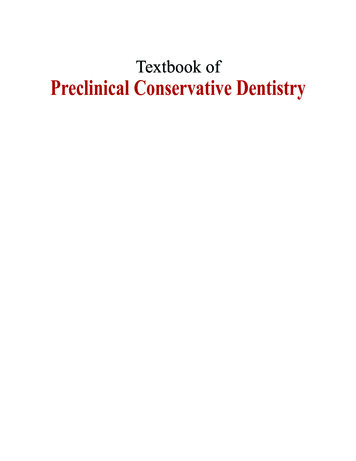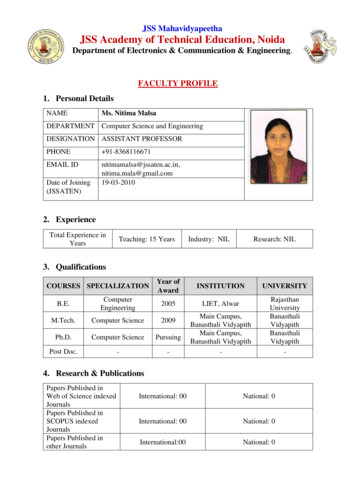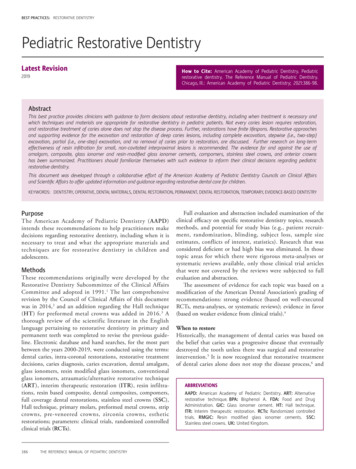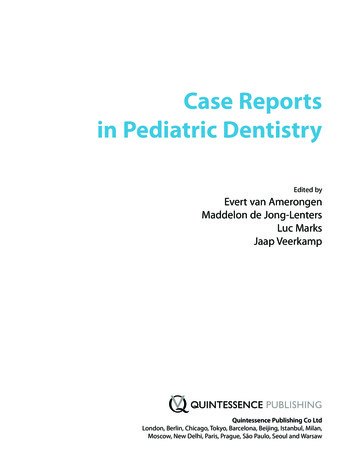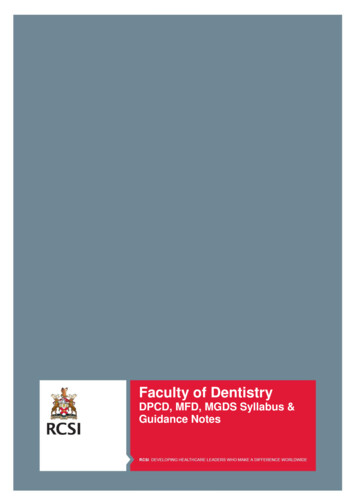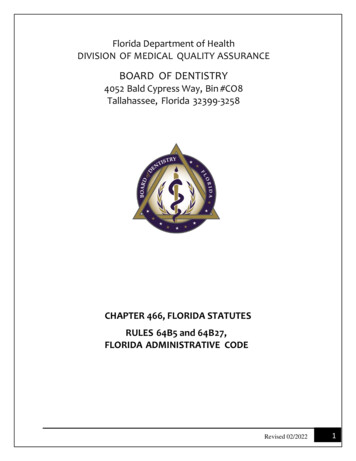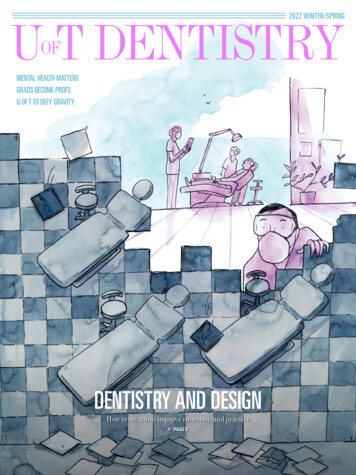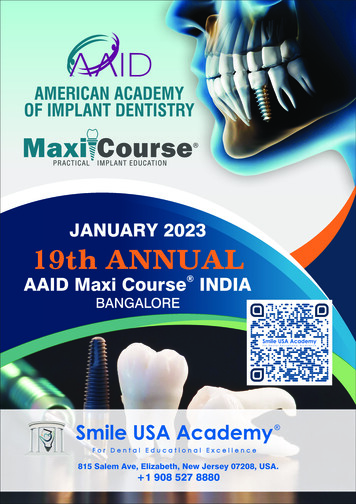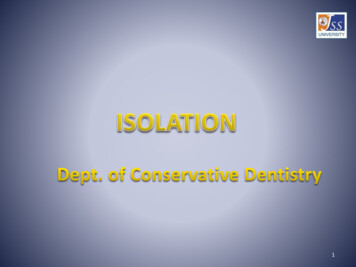
Transcription
1
ISOLATIONA techniquecontaminationor restorativeapplication ofto protect a tooth againstfrom oral fluids during a surgicalprocedure, usually through thea rubber dam or various othermeasures.2
CONTENT Objective of isolation Need for isolation in pediatric dentistry Methods for isolationDirect method Rubber Dam Other direct method Summary ReferencesIndirect method Drugs Advantages Disadvantages Indication Contraindication Precaution Armamentarium Sterilization Preparation, Placement & Removalof rubber dam Radiographic techniques Alternative methods Variation with age Error in application & removal Recent advances3
OBJECTIVES OF ISOLATION Dry field Access and visibility Patient protection To improve operating efficiencyIt is essential that there should be proper moisturecontrol , good accessibility and visibility as well asadequate room for instrumentation around the workingarea . Such an environment is necessary for easymanipulation and insertion of restorative materials.4
METHODS FOR ISOLATION- Direct methods- Indirect methods Rubber dam Cotton rolls and cottonroll holder Gauze pieces Absorbent wafers Suction devices Gingival retraction cord Mouth props Comfortable position ofpatient and relaxedsurroundings Local anesthesia Drugs :- Anti – sialogogues,Anti anxiety , Musclerelaxants5
DIRECT METHODRUBBER DAM Rubber dam provides the best possibleisolation by far. The Rubber Dam is a flat , thin sheet of latex ornon latex that is held by a clamp (retainer) and aframe that is perforated to allow the teeth thatwill be worked on to protrude through theperforations in the sheet while all the other teethare covered and protected by the rubber dam. It is used to define the operating field by isolatingone or more teeth from oral environment.6
ADVANTAGES Improvement of access. Retraction and protection of soft tissues. Provision of a dry operating field. Improve visibility. Provision of an aseptic environment. Prevention of ingestion and inhalation of foreignbodies. Aid to patient management. Aid to cross-infection control by reducing aerosolspread of micro-organisms. Minimization of mouth breathing during inhalationsedation procedure.KENNEDY7
DISADVANTAGES Time consuming. Patient’s objection. Trauma to marginal gingiva. Trauma to cementum Poorly retentive clamps. Metal crown margins show microscopic defectfollowing clamp removal. Ceramic crowns may fracture at the margins ifclamp is allowed to grip the porcelain8
INDICATION The use of the dam is indicated in virtually all (99.9%)cases. Certainly rubber dam is indicated in all operativeprocedures and endodontics. When using high copper amalgam , as it is influencedby moisture contamination. It has been used in diagnosis to isolate teeth forthermal test and interdentally during electric pulptesting. In periodontal therapy as an aid in root planing and incombination with a periodontal pack as a dressingfollowing flap surgery.9
CONTAINDICATION In the presence of some fixed orthodontic appliances. Partially erupted tooth can’t receive a retainer. Some third molars. Children suffering from asthma , some upperrespiratory infections or mouth breathing problems. Cannot be used in case of extremely malpositionedteeth. Latex allergy. Psychological intolerance. Patient at risk with transient bacteremia. Severe gingival disease.10
PRECAUTIONS The rubber dam should not obstruct patient’s airwayand thus should not cover his nose. Holes should be prepared in rubber dam forpatients with upper respiratory tract obstruction. On patients with allergy to latex , latex free rubberdam should be used. Rubber dam napkin can beused to prevent the latex rubber dam fromcontacting the patient’s tissues.11
ARMAMENTARIUM Rubber dam sheets Rubber dam clamps or retainers Rubber dam holder (frame) Rubber dam retaining forceps Rubber dam punch Rubber dam templates or stamps Dental floss Napkin Wooden wedges , orthodontic elastics &commercially available latex cord. Lubricant Modelling compound ScissorsSTUDERVANTS12
RUBBER DAM SHEETS Size – 5 5 inch ( 12.5 12.5 cm )6 6 inch ( 15 15 cm ) Thickness – Thin- 0.15 mm (0.006 inch)Medium- 0.20 mm (0.008 inch)Heavy- 0.25 mm (0.010 inch)Extra heavy - 0.30 mm (0.012 inch)Special heavy - 0.35 mm (0.014 inch) Colors - green , blue , black , pink and burgundyDarker color offers better visual contrast. Flavors – mint , banana and strawberry It has shiny and dull surface. Dull surface is keptfacing occlusally since it is less reflective.13
RUBBER DAM CLAMPS OR RETAINERS Used to secure the dam to the teeththat are to be isolated & to minimallyretract the gingival tissue. Parts - 4 prongs that rest on the mesial and distalline angle of the tooth and 2 jaws connected by abow. If extended beyond the mesial and distal line anglesof tooth –- Interfere with matrix and wedge placement- gingival trauma is more likely to occur- a complete seal around the anchor tooth is moredifficult to achieve.14
Continued Types : Winged Wingless Serrated Clamp with jaws inclined cervically to engageerupting tooth or severely broken down teeth. Clamps with endo – illuminator system toilluminate pulp chamber and canal orifices.WingedWingless15
RUBBER DAM HOLDERS (FRAME) Used to maintain the borders of the rubber dam inposition. The frame is U shaped and could be an adult orpedodontic , one made of metal or plastic. Types – 1) Metallic ( Young’s frame ) – Holder of a wire2 mm in diameter. Application is easy andcomfortable. Can be easily used in childpatient. 2) Plastic ( Nygaard ostby frame , Starlitevisiframe , Le Cadre Articule , quick dam ) –Useful when a radiograph is to be takenwithout removing the frame.16
Young’s Frame Nygaard Ostby Frame Starlite Visiframe Le Cadre Articule Rubber Dam Frame Handidam Optra Dam Instidam Dry Dam17
RUBBER DAM RETAINING FORCEPSSTOKESBREWERASH typeIt is a forcep that holds the retainer and facilitates itsplacements and removal from the tooth.18
RUBBER DAM PUNCHIt is a precision instrument having a rotating metaltable ( disk ) with six holes of varying sizes and atapered , sharp – pointed plunger.Use the smaller holes for the incisors , canines andpremolars and the larger holes for the molars. Thelargest holes is generally reserved for the posterior19anchor tooth.
RUBBER DAM TEMPLATES OR STAMPSBoth have positions of the teeth marked on them and areused to transfer them to the rubber dam sheet for holes tobe punched.20
STERILIZATION The rubber dam sheet itself with the rubber damnapkin and any floss or wedges used are disposableand so do not require sterilization. The rubber dam frame , clamps and clamp forcepsmust be carefully cleaned and sterilized betweenpatients , preferably in an autoclave. The rubber dam punch should not need to besterilized frequently , since it only contact the rubberdam before it is placed in the patient’s mouth. Punches are made with carbon steel componentstherefore hot air sterilization should be used.Reid,Callis,Patterson21
PREPARATION OF THE RUBBER DAMThree stages are involved :Stage-1 : SELECTION OF THE DAM Heavy and extra heavy dams are used for restorativeprocedures while medium is considered ideal forendodontic purposes since it:- retracts the tissues better than thin type- is easier to place than heavier type. The natural or translucent rubber dam has advantagesfor endodontic radiography with the dam in place.Reid,Callis,Patterson 22
Stage-2 : MARKING THE HOLES Punch an identification hole in the upper left corner of therubber dam for ease of location of that corner when applyingthe dam to the holder. Isolation of a minimum of threeteeth is recommended exceptwhen endodontic therapy isindicated , and in that case onlythe teeth to be treated isisolated. The distance between the holesis equal to the distance fromthe centre of one tooth to thecentre of the adjacent tooth ,measured at the level of thegingival tissue. This isapproximately ¼ inch (6.3mm).23Studervants
Stage-3 : POSITION OF THE HOLES Single tooth isolation It should be near the centre of the rubber sheet withinthe area of the sheet corresponding to the quadrantunder treatment. It is recommended that the top edge of the rubbersheet is positioned to lie above the lip of the patientduring endodontic procedures. Multiple tooth isolation If the dental arch is regular , a rubber stamp ortemplate can be used to indicate the positions of theholes. Templates are designed to be placed behind the rubberdam and the tooth positions marked with a pen. 24
PLACEMENT OF RUBBER DAMThree methods1. Dam first technique2. Clamp first technique3. Clamp and dam together techniqueKENNEDY25
REMOVAL OF THE RUBBER DAM Cutting the septa Removing the retainer Removing the dam Wiping the lips Rinsing the mouth Massaging the tissue and Examining the damSTUDERVANTS26
RADIOGRAPHIC TECHNIQUES Normal radiographic techniques , particularly filmpositions have to be modified when the rubber damframes and clamps are in place. Metal rubber dam frames are best avoided Varients on the bisecting angle techniques are used The simplest method is to remove the frame andplace the film as close as possible to the tooth. Use haemostats to hold the film for the short conebisecting angle technique. Frame removal is notrequired. Tongue spatulas can be used in place of haemostatsadvantage of being disposable and radiolucent. Simple plastic film holder ‘Rinn Eezee Grip’ can be27Reid,Callis,Pattersonused.
ALTERNATIVE METHODS Cervical retainer replacement Fixed bridge isolation Substitution of retainer with a matrixSTUDERVANTS28
VARIATIONS WITH AGE For younger - change the hole size- smaller sheet Primary teeth- HF no.27 retainerisolation is usually from the most posterior tooth tothe canine on the same side. Young permanent teeth – Ivory no. 14The jaws of the retainers used on primary and youngpermanent teeth need to be directed more gingivallybecause of short clinical crowns or because the anchortooth’s height of contour is below the crest of gingivaltissue.STUDERVANTS29
SLIT-DAM METHOD Rubber dam use in primary dentition is simplified bythe slit-dam method. Rather than punching multiple tooth holes in thedam and isolating each tooth in the quadrant , threelarge holes are punched out 1-2 cm apart and arejoined by a scissors cut. Such rubber dam application is rapid (5-10 sec) andthe desired teeth are completely available forrestorative treatmentDCNA ,39 -4 , OCT 199530
ERRORS IN APPLICATIONS AND REMOVALErrors - Prevent adequate moisture controlReduce access and visibilityCause injury to patientDifferent types of errors Off centre arch formInappropriate distance between holesIncorrect arch form of holesInappropriate retainerShredded or torn DamSharp tips of no 212 retainerSTUDERVANTS31
RECENT ADVANCES Hat Dam :Cushioning Metal Clamp JawLiquid Dam / Opal DamCusheesFiber Optic Clamps32
OTHER DIRECT METHOD COTTON ROLLS GAUZE PIECES ABSORBENT PADS/WAFERS RETRACTION CORD MOUTH PROPS
SUCTION DEVICES High Volume Vacuum Saliva Ejector Svedopter Isolite system34
INDIRECT METHODDRUGS Rarely indicated in restorative dentistry. Atropine (antisialogogues) -5mg , 30min before theprocedures - reduce salivation Antianxiety drugs like valium - 5 to 10mg 30min before. Muscle relaxants. Medication for controlling gingival bleeding. Pain control medication. Contraindication - nursing mothers andGlaucomapatients.35
SUMMARYA thorough knowledge of isolation reduces the physicalstrain on the dental team associated with daily dentaltreatment , reduces patient anxiety associated with dentalprocedures , and enhances moisture control , therebyimproving the quality of operative dentistry.36
REFERENCES Paediatric operative dentistry-KENNEDY Pediatric dentistry – Pinkham Dentistry for child and adolescent - McDonald Art and science of operative dentistry-Studervants Rubber dam in clinical practice - Reid, Callis, Patterson Pediatric dentistry , 2010;32-1, Jan-Feb DCNA , 1995; 39-4, Oct Fundamental of pediatric dentistry - Mathewson Internet37
Art and science of operative dentistry-Studervants Rubber dam in clinical practice - Reid, Callis, Patterson Pediatric dentistry , 2010;32-1, Jan-Feb DCNA , 1995; 39-4, Oct Fundamental of pediatric dentistry - Mathewson Internet REFERENCES. Created Date: 7/4/2017 2:18:12 PM .
